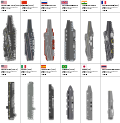Aircraft carrier
Aircraft Carrier
An aircraft carrier is a warship that serves as a seagoing airbase, equipped with a full-length flight deck and facilities for carrying, arming, deploying, and recovering aircraft. Typically, it is the capital ship of a fleet, as it allows a naval force to project air power worldwide without depending on local bases for staging aircraft operations.
History
The concept of the aircraft carrier dates back to the early 20th century. The first ship to launch an aircraft was the HMS Ark Royal, which was converted from a merchant ship in 1914. The first purpose-built aircraft carrier was the HMS Hermes, launched in 1924.
During World War II, aircraft carriers became the dominant naval vessels, replacing the battleship as the fleet's centerpiece. Notable carriers from this era include the USS Enterprise, which played a significant role in the Pacific Theater.
Design and Features
Modern aircraft carriers are equipped with a variety of features to support their role as floating airbases:
- Flight Deck: The flight deck is the most prominent feature, allowing for the launch and recovery of aircraft. It is equipped with catapults and arresting gear to assist in takeoff and landing.
- Hangar Deck: Below the flight deck, the hangar deck is used for storing and maintaining aircraft.
- Island: The island is the command center of the carrier, housing the bridge and flight control.
- Propulsion: Many modern carriers, such as the USS Ronald Reagan, are powered by nuclear reactors, allowing them to operate for long periods without refueling.
Types of Aircraft Carriers
Aircraft carriers can be classified into several types based on their size and capabilities:
- Fleet Carriers: These are the largest carriers, designed to operate with the main fleet and project power globally. Examples include the USS Abraham Lincoln and the HMS Queen Elizabeth.
- Light Aircraft Carriers: Smaller than fleet carriers, these ships provide air support for smaller naval operations.
- Escort Carriers: Used primarily during World War II, these carriers provided air cover for convoys and amphibious operations.
- Amphibious Assault Ships: These ships, such as the USS Wasp, are designed to support amphibious warfare operations and can carry helicopters and VTOL aircraft.
Notable Aircraft Carriers
- USS Enterprise (CV-6): A key player in the Pacific during World War II.
- HMS Ark Royal (R09): Famous for its role in the sinking of the Bismarck.
- Shinano: The largest aircraft carrier built during World War II.
- USS Enterprise (CVN-65): The world's first nuclear-powered aircraft carrier.
Related Pages
Gallery
Transform your life with W8MD's budget GLP-1 injections from $125.
W8MD offers a medical weight loss program to lose weight in Philadelphia. Our physician-supervised medical weight loss provides:
- Most insurances accepted or discounted self-pay rates. We will obtain insurance prior authorizations if needed.
- Generic GLP1 weight loss injections from $125 for the starting dose.
- Also offer prescription weight loss medications including Phentermine, Qsymia, Diethylpropion, Contrave etc.
NYC weight loss doctor appointments
Start your NYC weight loss journey today at our NYC medical weight loss and Philadelphia medical weight loss clinics.
- Call 718-946-5500 to lose weight in NYC or for medical weight loss in Philadelphia 215-676-2334.
- Tags:NYC medical weight loss, Philadelphia lose weight Zepbound NYC, Budget GLP1 weight loss injections, Wegovy Philadelphia, Wegovy NYC, Philadelphia medical weight loss, Brookly weight loss and Wegovy NYC
|
WikiMD's Wellness Encyclopedia |
| Let Food Be Thy Medicine Medicine Thy Food - Hippocrates |
Medical Disclaimer: WikiMD is not a substitute for professional medical advice. The information on WikiMD is provided as an information resource only, may be incorrect, outdated or misleading, and is not to be used or relied on for any diagnostic or treatment purposes. Please consult your health care provider before making any healthcare decisions or for guidance about a specific medical condition. WikiMD expressly disclaims responsibility, and shall have no liability, for any damages, loss, injury, or liability whatsoever suffered as a result of your reliance on the information contained in this site. By visiting this site you agree to the foregoing terms and conditions, which may from time to time be changed or supplemented by WikiMD. If you do not agree to the foregoing terms and conditions, you should not enter or use this site. See full disclaimer.
Credits:Most images are courtesy of Wikimedia commons, and templates, categories Wikipedia, licensed under CC BY SA or similar.
Contributors: Prab R. Tumpati, MD








